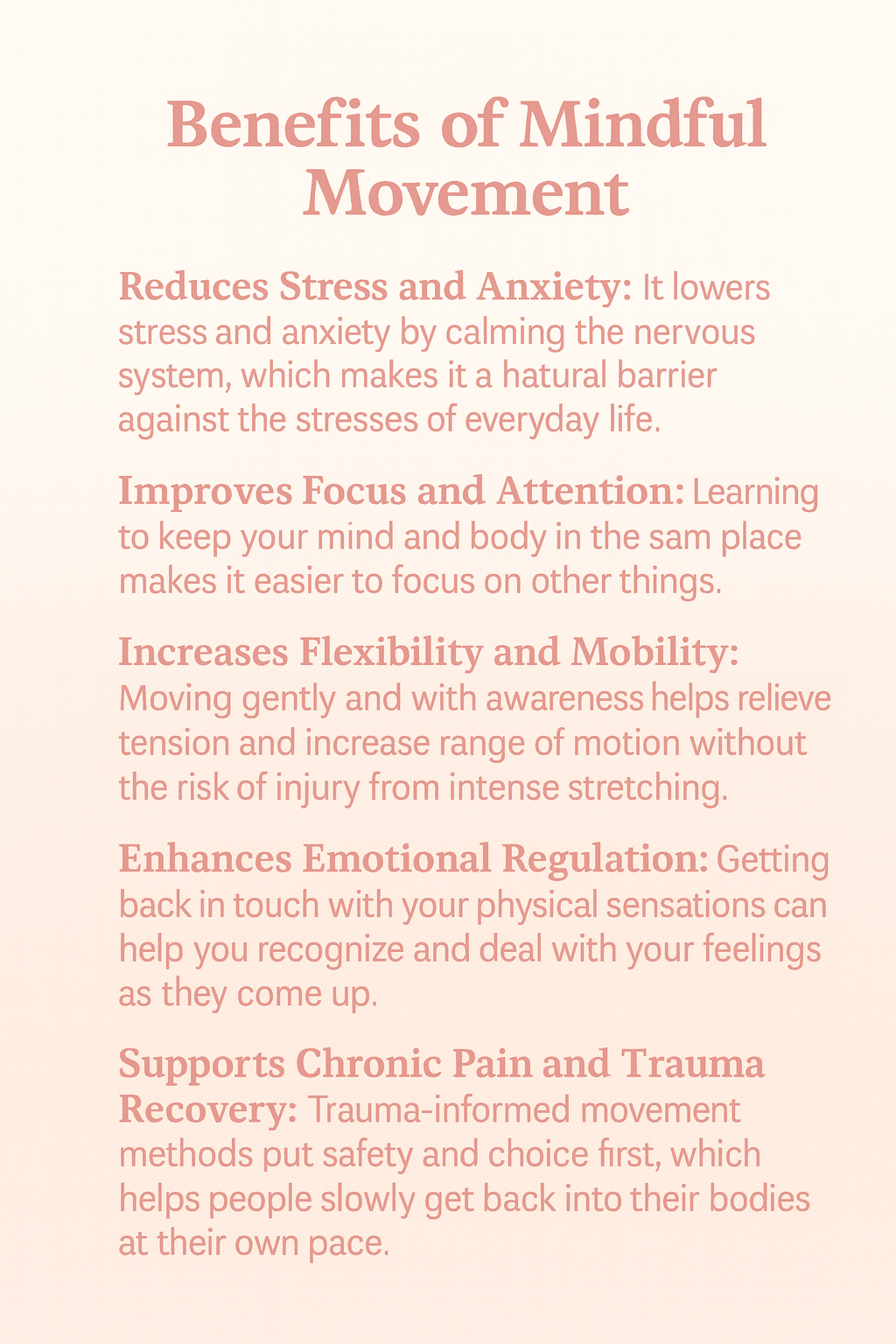What Is Mindful Movement? A Gentle Way to Reconnect Mind and Body

Sarah Johnson, MD

Do you feel like your body is just a vehicle for your busy mind to get from one task to the next? Are you rushing through your workouts just to get them done, or are you stuck at your desk for hours on end, only to end the day with a stiff neck and a racing mind? We often ignore our bodies and push through fatigue in order to get things done in our fast-paced world.
This constant rushing makes our minds and bodies feel separated, which makes us feel stressed, disconnected, and physically stuck. The mindful movement is one way to close this gap. It's a habit of taking your time to really hear what your body and mind need. It's not about losing weight or beating your best time; it's about getting back to who you are.
What is mindful movement, and why is it gaining attention in wellness circles? This practice is a gentle, embodied way to reduce anxiety, release physical tension, and improve mental clarity. Unlike traditional workouts, the mindful movement encourages slow, intentional motion that restores balance to your nervous system. In this guide, we’ll explore how mindful movement practices like somatic stretching or conscious walking can be easily integrated into your daily routine — without needing special equipment or fitness experience.
If your racing mind makes it hard to slow down, exploring support from an AI therapist for mental health can be a helpful first step.
better with Soula

Support for every woman:
✅ A Personalized Plan to reduce anxiety and overthinking
✅ 24/7 Emotional Support whenever you need it Cycle-Aligned Mental Health Tracking — monitor your mood and symptoms in sync with your period
✅ Real-Time Insights into your energy levels and emotional state
✅ Bite-Sized Exercises to help you return to a calm, balanced state — anytime, anywhere
What Is Mindful Movement?
Mindful movement means paying full, non-judgmental attention to any physical activity. It is movement with awareness of the present moment, and the main goal is not fitness or looks, but connection. Exercise usually focuses on things like speed, strength, or losing weight, but the mindful movement focuses on how you feel inside: the rhythm of your breath, the feeling of your muscles lengthening, and the feeling of your feet connecting with the ground.
There are many ways to do this. It includes structured practices like yoga, tai chi, and qigong, but it also includes simpler things like walking, stretching, or even doing everyday tasks with full awareness. You can make washing dishes or walking to your car while feeling the air on your skin into intentional movements.
What is mindful movement at its core? It’s a form of somatic movement — a practice rooted in body awareness and interoception. This approach emphasizes internal sensation over external performance, helping you reconnect with your body’s cues and regulate emotional stress. As part of trauma-informed or nervous system-friendly routines, the mindful movement supports healing from chronic stress, burnout, and physical stagnation. It’s not just movement — it’s a return to embodied presence.
The Science and Philosophy Behind the Mindful Movement
The Neuroscience
Science backs up the benefits of the mindful movement. This practice has a direct effect on your nervous system. Moving slowly and with purpose tells your body that you are safe. This helps lower stress hormones like cortisol and turns on the parasympathetic nervous system, which is your body's "rest and digest" mode — a process also supported by micro meditation and movement practices that calm the mind in short, focused sessions. This change is very important for getting better, digesting food, and keeping your emotions in check.
What is mindful movement's role in awareness? It also improves your interoception, which is your brain's ability to feel and understand signals from inside your body. Better interoception helps you understand your feelings better, recognize when you're hungry or full, and feel tension before it turns into pain.
The Mind-Body Connection
The idea behind the mindful movement is old and understands that the body and mind are closely connected. Modern science backs this up: movement has a direct effect on mood, sleep quality, and how well you can control your emotions. Endorphins are released during physical activity, which can help the body deal with stress hormones.
For a lot of people, mindful movement is like a moving meditation. It has the same calming effects for people who have trouble sitting still during traditional meditation. The mind has something to hold on to when it focuses on the body's movement, which helps restless thoughts settle and creates a state of calm focus. You can combine it with simple mindfulness exercises to deepen the sense of presence.
Benefits of Mindful Movement
Adding the mindful movement to your daily routine can help both your mind and body in many ways:

What is mindful movement's lasting benefit? Mindful stretching and slow movement are good for relieving stress right away and for a long time, as these body-mind practices show.
Examples of Mindful Movement Practices
You don't need to join a gym or buy special equipment to get started. Here are some easy-to-follow tips:
Yoga Mindful breathing + slow movement
This old practice builds strength, flexibility, and deep awareness by combining slow movement, mindful breathing, and held postures.
Walking Meditation
Don't walk to get somewhere; walk to have an experience. Take your time and pay attention to how each step feels: the lift, the swing, and the placement of your foot. Listen to and look at the things around you without judging them.
Qigong or Tai Chi
These ancient Chinese mindful movement practices involve slow, flowing movements that are meant to balance and cultivate the body's energy
Somatic Exercises or Feldenkrais
These gentle, therapeutic methods use tiny, internalized movements to retrain the nervous system and make you more aware of your body and how it works.
Simple Stretching or Even Daily Tasks
Anything can be mindful. As you reach for a high shelf, you should feel the stretch in your side. Watch how your arms move while you brush your teeth. Be completely focused on the task.
How to Start a Mindful Movement Practice
Starting is easy. Be kind to yourself and start small.
- Find a Quiet Place: Pick a spot where you won't be disturbed for 5 to 10 minutes.
- Start Small: Just 5–10 minutes at first. Consistency is more important than how long it lasts.
- Concentrate on the Basics: Focus on your breathing, the way your body feels, and the slowness. If your mind starts to drift, gently bring it back — grounding yourself with the 5-4-3-2-1 grounding technique can also help you stay present.
- Let Go of Performance: Stop worrying about how well you're doing. Let go of any goals you have to do it "right" or get a certain result. The mindful movement is not a race.
- Use Guides if Helpful: For structure, consider following a beginner's video on what is mindful movement on YouTube or using an app.
- Stay Curious: Don't criticize your practice; instead, be curious and kind.
These tips for slow, deliberate movement can help you create a mindful daily routine that lasts.
When to Try Mindful Movement
The mindful movement can be used in many ways. The best times to practice are usually:
- First thing in the morning to start the day off right.
- During a break in the middle of the day to recharge and fight off afternoon slumps.
- Before bed, to relax the body and calm the mind so you can sleep.
- Any time you feel stressed, anxious, or disconnected from your body.
What is mindful movement's most important rule? To listen to your body. If you have a serious injury or a history of trauma, it's important to talk to a doctor or a trauma-informed professional before you start the mindful movement. Some people may find stillness or certain feelings triggering, so it's important to go slowly and respect your limits without feeling rushed.
FAQ About Mindful Movement
Do I need experience with yoga or meditation to try mindful movement?
No, this practice is open to everyone, even people who have never done it before. It's not about how good you are at something; it's about your own experience.
Can mindful movement replace exercise?
It can help you recover and become more aware of your body, which can help with more intense exercise. For some people, it's a great way to move every day without putting too much stress on their bodies.
How is it different from regular stretching or walking?
The difference is in the intention and awareness. A mindful walk is about how it feels, while a regular walk is about getting somewhere fast.
Can I practice mindful movement with chronic pain?
Yes, a lot of people find it helpful. The most important thing is to move slowly, only as far as you can without pain, and always put comfort first. Above all else, pay attention to your body.
What if I get distracted?
It's perfectly normal and expected to be distracted. The practice is simply being aware that you are distracted and gently bringing your attention back to your breath or body without judging yourself.
Small Movements, Big Shifts
You don't have to do anything fancy or hard to get the benefits of the mindful movement. Even the smallest actions, when done with awareness, can have a big impact on your health. You can change how you feel about yourself by spending a few minutes a day rebuilding trust and communication between your mind and body.
So, we ask you to start small. Take it easy. Pay attention to how you feel. What is mindful movement if not this simple act of listening? Your body has been trying to tell you something all along; it's worth taking a moment to listen. Even a few mindful minutes can feel like a mental health vacation mindset — a pause that restores your balance without leaving home.














